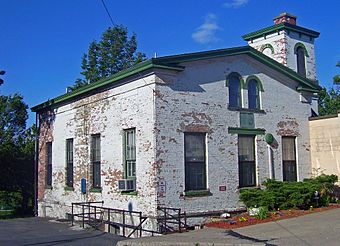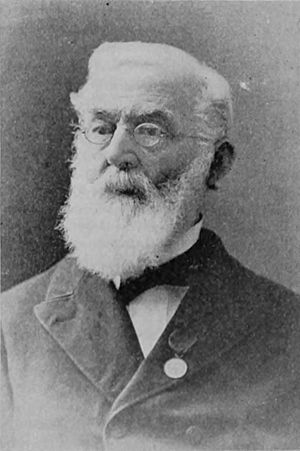James Hall Office facts for kids
|
James Hall Office
|
|

West profile and south (front) elevation, 2008
|
|
| Location | Lincoln Park, Albany, NY |
|---|---|
| Built | 1852 |
| Architect | Calvert Vaux and Andrew Jackson Downing |
| Architectural style | Italianate |
| NRHP reference No. | 76001204 |
Quick facts for kids Significant dates |
|
| Added to NRHP | December 8, 1976 |
| Designated NHL | December 8, 1976 |
The James Hall Office is a special old building in Lincoln Park, Albany. It used to be part of the Sunshine School. This small brick building has an Italianate style. It is now connected to a newer school building.
In 1976, this office was named a National Historic Landmark. This is a very important title for historic places. It got this title because of its connection to James Hall. He was a very important American geologist in the 1800s.
This building is also special because it was designed by Andrew Jackson Downing and Calvert Vaux. They were famous architects who worked together for a short time. James Hall was a paleontologist, which means he studied fossils. He spent a lot of time in this building. It was his office and his lab. Here, he made many discoveries. For example, he found that stromatolite fossils from Petrified Sea Gardens were once living things.
Later, the building was made a bit bigger. It was connected to an elementary school in Albany. It was used as a school until 2011. Now, the school district plans to sell it. The Boys and Girls Club of Albany is planning to buy it.
What the Building Looks Like
The old office is on the northwest side of the school building. It is in the southwest part of Lincoln Park. A road in the park leads to a parking lot on the west side. Morton Avenue is about 300 feet (100 meters) south of the building.
To the west, there is a large swimming pool for kids. There are also basketball and tennis courts. These are along Delaware Avenue, which is also U.S. Route 9W. North of the office is another, bigger school. A wooded area helps separate the park from the Center Square/Hudson–Park Historic District.
To the east, the park goes for about half a mile (800 meters). It slopes down towards the Hudson River, which is another mile (1.6 km) away. The South End–Groesbeckville Historic District starts near Morton Avenue.
The building itself is one story tall. It is made of brick and has a gently sloped roof. A small tower is on its southeast corner. This tower has a flat roof and a brick chimney. The building is connected to the school on its east side. There is a stairway to the basement at the southwest corner. The building is painted white, but some paint is flaking off. It has green trim.
A line of bricks sticks out between the basement and the first floor. The windows have six-over-six panes. They have simple brick sills. The main window on the front (south) side has a similar brick top. The main door is next to this window.
Above the main window, there is a special commemorative plaque. Above that, there are two smaller, arched windows. The roof has a decorative edge called a cornice. The tower has a brick line dividing its top and bottom parts. Each side of the tower has a small arched window. Small brackets hold up the cornice.
History of James Hall's Office
James Hall was born in Massachusetts. He came to the Capital District to study at what is now Rensselaer Polytechnic Institute (RPI). This school is in Troy. Hall also went on trips to study rocks with Ebenezer Emmons. These trips helped him decide to become a geologist. After college, he worked at the RPI library. Then, he started working for New York State's new geological survey. This became his life's work.
In 1843, Hall wrote an important report about New York's geology. This report made him famous as a leading expert in stratigraphy (the study of rock layers) and paleontology. The state then asked him to write a report about all the fossils in New York. This huge report had eight volumes and 13 parts. It is considered a classic in American science. It was finally published in 1894, four years before Hall passed away. During this time, he was the state geologist for New York, Iowa, and Wisconsin. He also became the director of the New York State Museum.
James Hall's work involved looking at many rock and fossil samples. These samples came from all over the country, not just New York. By 1850, he had too many samples for his state office. So, he had this new building built just for himself and his helpers. Andrew Jackson Downing and his student Calvert Vaux designed it. They used the Italian villa style, which Downing had made popular. The building looks very much like a drawing in Downing's famous book, The Architecture of Country Houses.
Downing and Vaux stopped working together in 1852. Downing died in a steamboat accident on the Hudson that year. The building was finished in 1852. It is one of the few buildings that both Downing and Vaux designed together.
In the 1880s, Hall built a house for his family nearby. But he still spent so much time working in his office. Sometimes he even slept there. Because of this, he and his family grew apart. In 1885, the state wanted him to work in one of their offices. However, he kept spending a lot of his time at his 1852 office. He worked there until he died 13 years later. His office was one big room. It was filled with charts, rock samples, and books. He had a simple bedroom off to one side.
By 1916, the city owned the building. That year, the geological survey put up a plaque on the building. This plaque remembers Hall's life and work there. At some point, the building started being used as a school. This was before it became a National Historic Landmark. It was connected to the Sunshine School building shortly after that.
The school stayed open until 2011. After it closed, the Albany City School District decided to sell the building. The Boys & Girls Club of Albany is currently planning to buy it.
More to Explore




